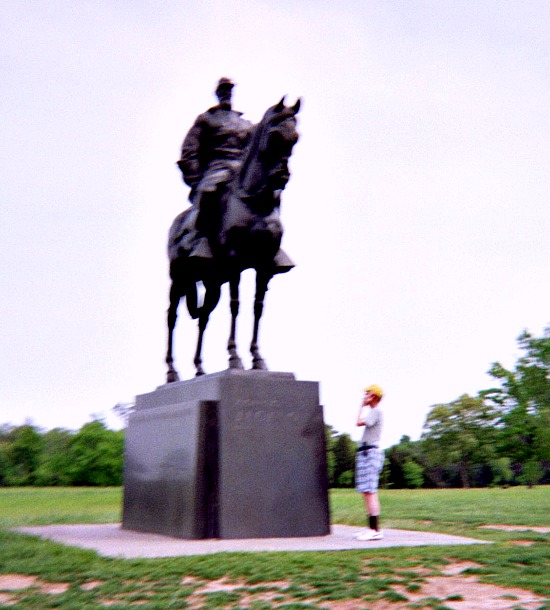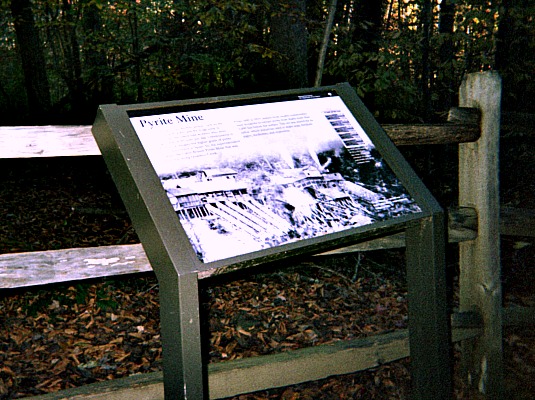Teaching history skills examples
Teaching history skills should include using technology for history and social studies instruction. Ken Halla, a 22-year-teaching veteran has paved the way toward including the use of mobile phone technology in his ninth-grade World History and AP Government classes.
 Students can use their mobile phones to learn about this statue at a well-known Civil War battlefield.
Students can use their mobile phones to learn about this statue at a well-known Civil War battlefield.According to Ken Halla, “Not every classroom can get a laptop every day, so [devices like smartphones], even if you have to pair up, become something useful for teachers. The number of kids with phones has just been blown out of the water the last couple of years. Two years ago, if any of the kids in my room had a phone, it was a dial-phone that maybe they could text on. And now it’s all smartphones.”
Seventh grader Sarah uses her mobile phone to participate in a brainstorming poll that her history teacher had projected onto the whiteboard. The teacher was teaching history skills with Poll Everywhere to ask students to provide opinions about the important cause of the American Civil War. Choices included slavery, states’ rights versus federal rights, the election of Abraham Lincoln as President of the United States, social issues or financial issues. Sarah sent in her response, then watched the percentages in the bar graph on the whiteboard change as more students texted in their votes.
During class, Sarah’s teacher asked the students to send in text messages explaining their reason for their poll choice. Because the answers were anonymous, students were comfortable giving their honest opinions. After Sarah sent in her answer, she was influenced by the viewpoints of other student answers she saw displayed on the whiteboard.
After the teacher reviewed the student answers in class, she organized the students into groups. Their assignment was to create an 8-to-10-minute podcast debating the merits of two different viewpoints on the major cause of the war.
To research their two viewpoints, the groups used their mobile phones teaching history skills to search different sources on the mobile Internet. Once they gathered their data and developed their podcast, the history students called in to the teacher’s Google Voice number and recorded their podcasts in her private account. The podcasts were converted to downloadable MP3 files. Later, the teacher would listen to them on her phone, evaluate them, and text message her feedback to the students as part of her teaching history skills.
As students left the class, the teacher told them to use their phones to take a picture of the bar code she had posted by the doorway. The bar code was a way for them to read a text of Lincoln’s Gettysburg Address and watch a short video from Ken Burn’s documentary The Civil War. Her teaching history skills had also included their homework assignment accessible via the bar code. It was to read the text, watch the video, and then send in a 140-character text-message summary of the Gettysburg Address to the class brainstorming board. The next day in class, the students would compare and evaluate the different summaries.
Teaching history skills tips
There is a way to be sure that your students are using their mobile devices for educational purposes and not for social activities. Flip the classroom dynamic from lecturing at the front of the room to walking around the classroom observing your students instead.
During class, Ken Halla walks around his classroom helping students with their work. At the same time, he keeps an eye on the behavior of his students to make sure they are staying on task. “It’s harder to do the negative behaviors when the phones are out and the teaching is walking around,” he explains.
Remind101 is an app that helps students stay organized. Students voluntarily sign up to receive a text reminder when they have an upcoming assignment due. Parents can also sign up for the app to monitor the status of their children’s homework assignments. According to Ken Halla, “I was stunned by how many more kids started doing the homework. I just thought they didn’t want to do the work, but it was more that they were unorganized and had forgotten to do it.”
History teacher Ken Halla recommends polleverywhere.com in his resources of teaching history skills to test students’ knowledge of their subject lessons before an approaching test. Teachers can set up a question or questions based on what the students are learning in class. Students see the question with several potential answers and then they’ll text in the answer. As the students’ answers are compiled, the site creates a graph showing their responses. “It’s a good way to see how the students are comprehending the material,” according to Ken. “For example, if a lot of students are picking option C and B is really the answer, then I can go back and review the material again.”
Ken Halla recommends a number of apps that are part of teaching history skills. These apps help teach social studies courses. These are World Wiki, an app that provides demographic information for almost 250 countries around the world. iAmerica is an app with information about each American President and the history of the White House. U.S. Constitution provides students with easy access to one of the most important American documents.
As a final tip, Ken suggests being open to letting students have some fun with their devices. He was surprised to discover that his students are quieter and more focused on their assignments when they are permitted to listen to their music during individual classwork.
They should use headphones and not play loud music that would distract their fellow classmates. Students should only use sites that stream music. They can stay on task without stopping to look for a new song every few minutes. According to Ken, “It’s amazing. “The noise level in the classroom goes down, and the work amount goes up when you let them listen to their music.”
Not all learning can happen digitally. When it’s time to return to classroom instruction, Ken tells his students to remove their earbuds, put down their phones and listen to his instruction.
He explains that teachers have to adapt to the changing times and find a way to successfully incorporate mobile phones into the classroom. “I’ve always been that type of person who likes to adapt and change as time goes on,” Ken explains. “Otherwise, I wouldn’t still be teaching this many years down the road.”
Teaching history skills include using mobile phones
Instant podcasts and oral recordings are the easiest activities with a mobile phone. Many resources allow students to post their phone calls online as audio files or podcasts. Teachers can also create a Google Voice account that provides a free local phone number associated with the teacher’s phone or voice mailbox. Students can leave recorded homework assignments or test answers.
Mobile geotagging is the ability to post media (photos, video, audio, or text) from a mobile phone to a specific point on a map. Some websites work with basic mobile devices to allow geotagging. For example, Flagr allows users to create public, semiprivate, or private maps. Anyone who has a Flagr account and is a member of a particular map’s group can send a photo or text message to a specific point on that map.
A history teacher assigns his students to create an audio tour about local history. The students go to various historical monuments and buildings in the community and then phone in historical summaries of the significance of these sites to GeoGraffiti, which places the oral recordings in the appropriate geographic locations on the map. This teaching history skills activity enables students to research local history, practice public speaking and learn geography in one assignment.
Yodio enables students to create and participate in individual or collaborative digital storybooks using a mobile phone. Mobile phones can help with student organization of their assignments if students take advantage of services like Jott or Dial2Do. These voice-to-text services enable users to call in reminders to themselves, send e-mails or text messages to groups of people and create posts. They can also create a schedule on a Google calendar, listen to their e-mail, podcasts and webpages on the go.
Teachers can design instructional activities that teach students to use their mobile phones as an anytime, anywhere research and information-gathering devices. For example, while on a field trip to historical Williamsburg, Virginia, a teacher directs his class to send any questions that occur to them to the free information site ChaCha.
Ken Burn's documentary about the Civil War.









